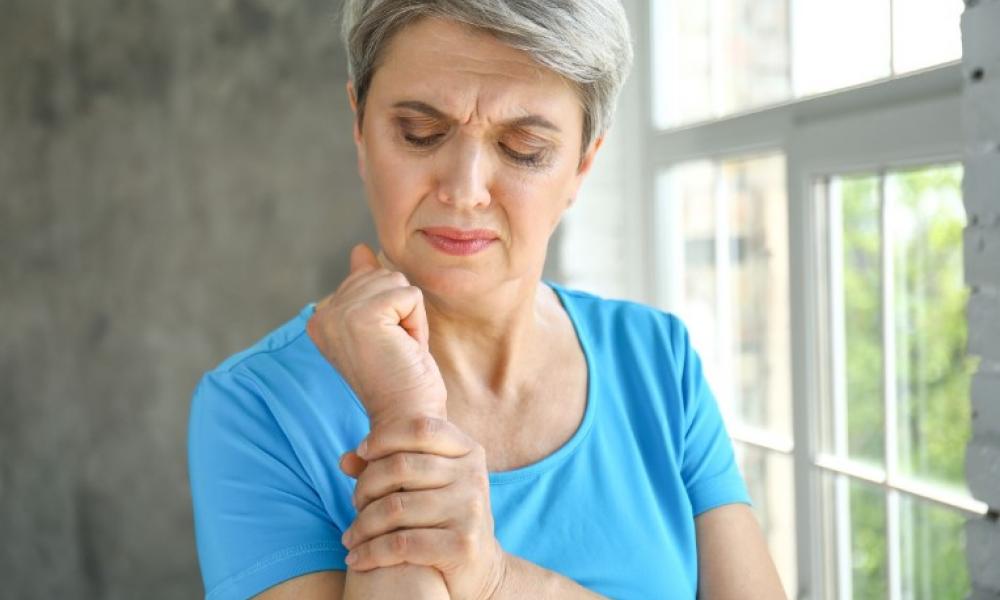
What is osteoporosis
Osteoporosis is a condition where your bones become weak and brittle. It occurs when bones lose minerals such as calcium faster than the body can replace them. This causes bones to break more easily.
There are no signs or symptoms of osteoporosis. People often do not realise they have it until they have a broken bone.
Osteoporosis can affect both men and women. Although, women over 50 are at higher risk of developing it. This is because oestrogen levels fall after menopause which can cause faster loss of bone mass.
Why does axial spondyloarthritis increase the risk of osteoporosis?
Axial spondyloarthritis (axSpA) causes inflammation which over time can wear away bone tissue. In people with axSpA, new bone tissue does not form fast enough to replace the bone lost from chronic inflammation. This increased bone loss can lead to osteoporosis and risk of bone fractures. Especially within the spine.
Osteoporosis is linked to disease activity (severity). Which means when your arthritis is well managed, and your inflammation is under control the risk of developing osteoporosis is reduced. In people with advanced axSpA, chronic inflammation can lead to growth of extra bone. This can cause the joints in the spine to fuse together (ankylosis). Resulting in reduced mobility which can increase the risk of osteoporosis. Reduced mobility can increase the risk of falls. This combination of weakened bones and risk of falls increase the risk of fracture.
Other risk factors for osteoporosis
There are a range of other factors that are linked to an increased risk of osteoporosis. Some of these risk factors are listed below:
- Age. People over 50 have an increased risk of a bone fracture. This is because after age 50 loss of bone density accelerates. This is particularly true for women at the time of menopause, when the hormone estrogen rapidly falls.
- Family history. A family history of osteoporosis increases the risk for both men and women.
- Physical inactivity.
- Smoking.
- Excessive alcohol consumption.
- Low calcium and vitamin D intake. Adults require 1,000 mg per day increasing to 1,300 mg per day for women over 50 and men over 70 years. Vitamin D is needed to absorb calcium. Sunlight is the main source of vitamin D. The amount of sunlight exposure required to produce adequate levels of vitamin D is low. Avoid prolonged sun exposure to avoid the risk of skin cancer.
- Being overweight or underweight. Hormones linked with weight may affect bone.
Other medical conditions can increase the risk of osteoporosis and fracture in people with or without axSpA. These include:
- Conditions that make it difficult for the body to absorb nutrients from food, including coeliac disease and inflammatory bowel disease.
- Diabetes
- Chronic liver or kidney disease
- Thyroid conditions.
How is osteoporosis diagnosed in people with axSpA?
People with osteoporosis often don’t know they have it until they have a broken bone. The following tests may be used in diagnosing osteoporosis:
- Bone mineral density (BMD) test is an x-ray that measures bone mineral and calcium density. The most accurate BMD tests is a dual energy x-ray absorptiometry (DXA) test.
- Blood test
- Review of medical history
- Physical examination
How is osteoporosis treated?
Treatment for osteoporosis is a medication called bisphosphonates. It works by reducing the cells in the body that breakdown bone. They are an effective treatment to reduce bone breakages in people with osteoporosis.
Studies have shown that TNF inhibitors, a type of biologic medications used to treat axSpA can help improve bone mineral density in people with axSpA. However, there is no evidence that it reduces the risk of fracture.
Ways to help reduce your risk
Besides medication you can make lifestyle changes to reduce your risk of developing osteoporosis. Below are some suggestions to help protect your bones:
- Quit smoking. If you smoke, try to stop. Smoking has been linked to an increased risk of osteoporosis. It can bring on early menopause which can lead to earlier bone loss. Smoking also makes it difficult for the body to absorb calcium. Speak with your doctor or you can call the Quitline on 13 78 48 or go online at icanquit.com.au. The Quitline has Aboriginal and other languages advisors available.
- Eat a healthy diet. A healthy diet is important for your general health, and for maintaining bone health. Calcium and vitamin D are particularly important for healthy bones. Good sources of calcium include low-fat dairy, leafy green vegetables, fish such as salmon. It can also be found in nuts, seeds, soy and tofu, and calcium enriched foods such as breakfast cereal and fruit juice. It is recommended that you have 3 or 4 servings of calcium -rich food per day. The Australian Dietary Guidelines can help you identify good sources of calcium-rich foods.
- Try to move regularly. Physical activity is important for building muscle and bones strength. Weight-bearing exercises, like walking, climbing stairs and lifting weights are good to protect against osteoporosis. Flexibility and balance exercises will lower the risk of falls.
- Talk to your doctor about your medications and supplements. You may benefit from the addition of calcium or vitamin D supplements. It is always important to talk to your doctor about the use of medications and supplements to help understand the risks and benefits. It can also form a shared decision-making process, where you work with your health care team to make choices about your own treatment.
- Understand your risk of osteoporosis. You should talk to your doctor as soon as you have been diagnosed with axSpA or are over the age of 50 about your risk of osteoporosis.
This resources has been developed based on the best available evidence. A full list of resources is available on request.









